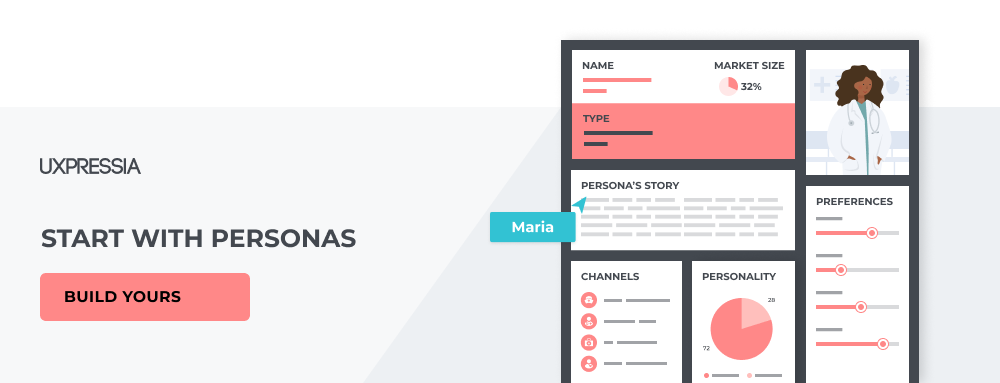What does the term UX Designer mean to you? To Dr. Deirdre Kelly, Manager of Organizational Effectiveness at NAV CANADA, it’s a broad term that encompasses designers, researchers, and those who work in the space of user interface design. These professionals are trying to discover the truth about how people work, as well as use products and services. And then come up with new opportunities. They try to enhance and improve the things that are out in the world. And make those more accessible to the people who use them and deliver a better experience.
At our recent event, Dr. Kelly talked about her UX journey stage by stage and the lessons she learned along the way. Read on to find out the answers along with real-life examples, self-reflection advice on what could be done differently, and current practices. Or you may scroll down till the article’s end and watch the full event recording.
Contents
Lesson One: Ask questions
It is very helpful to put on an ever-engaged four-year-old mindset and start asking questions about why the things are the way they are. By asking “why?”, you will learn a lot and understand better the world around you and other people’s perspectives.
It actually was that question that energized and fostered Dr. Kelly’s engagement, not only throughout her entire UX Designer career but her whole life.
“My earliest UX research projects were around the time I was 10 or 11 years old. And I was trying to understand the ethnographic perspective of people with fibromyalgia. I wanted to understand what it was like to experience the world with a chronic pain disorder. So I went out and interviewed people. I learned a lot of things that I didn't understand because that wasn't my experience in the world. I was able to create some recommendations. They were only featured at the time in my local science fair. But that being said, this definitely propelled me to continue asking questions and continue talking to people in spaces where I didn't necessarily have firsthand experience. The spaces I was very, very curious to learn more about.”
Lesson Two: Foundational understanding is not only about users
A foundational understanding is not only about knowing your user. It's also about knowing yourself.
Most of us understand that there's value in reaching out to, understanding, and hearing our users, their stories, and their words, and then looking at things from their perspective and really learning from what they have to say.
From a cognitive perspective, a key part of doing this well is starting from a foundation of knowing yourself, knowing your own story, knowing your own biases and how they show up, and knowing how those biases form the way you interact with other people.
So start from self-knowledge and then move to a perspective of appreciating system complexity. What does that mean? As a UX Designer, you are embedded in a complex system. And by understanding how that system informs your behavior and user’s behavior, you will be able to create products and services that work well.
Example: The all-in researcher
This example illustrates how a communication approach chosen by the researcher can shut down the communication before it comes in or before the conversation even gets started.
So what was at play here from a cognitive perspective? One of the things was confirmation bias. Here is an example: if you have an idea that something's broken, you are looking for the signs that it is in fact broken. If you believe all is good, you will look for the signs confirming that it is in fact good. You tend to disregard more readily things that don't conform to your view of the world, the beliefs you have, the things you believe to be true.
So if you come in with the idea that there is a problem that needs to be solved, you are very much going to look for further signs that there is a definite problem rather than approaching it from the perspective of understanding what about the product or service works and where are the barriers in addition to the challenges.
“If I had approached the conversation from the perspective, instead of jumping into “just solve the problem” and looking for the things that were not working, maybe I would have had a better first conversation with this primary process owner.”
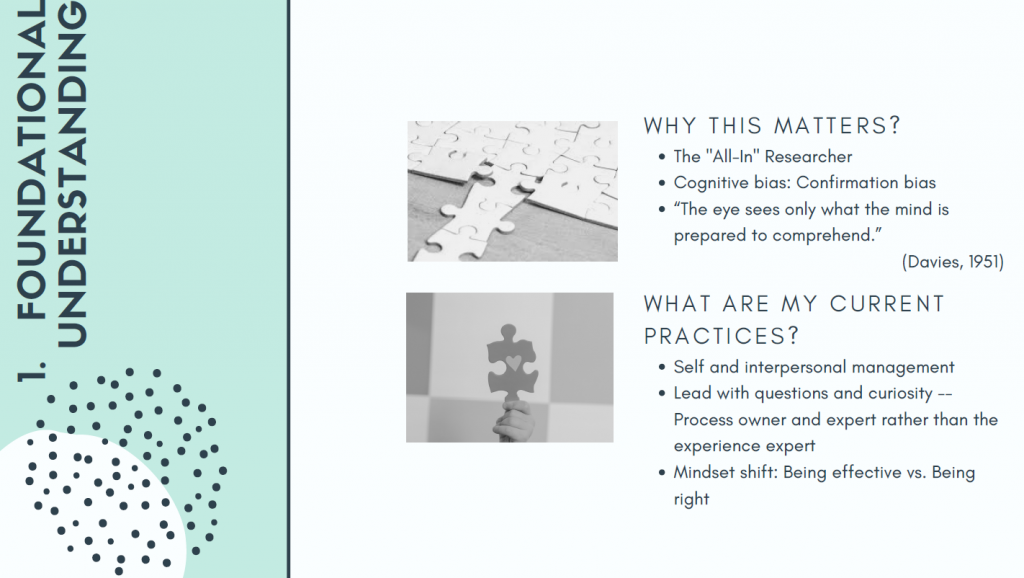
Current practices
Today, Dr. Kelly embraces a more patient and open-minded approach. Handling challenges with a more balanced approach and exercising more caution to ensure that she looks for a systematic and balanced understanding of the challenge and user needs. Prior to advancing, she does her homework to better understand the challenge from multiple perspectives, especially those of key stakeholders.
Dr. Kelly engages in understanding her own and others’ existing assumptions about the challenge she is tackling, as well as mapping any known joy and points in advance of meeting with a client.
So this is about self- and interpersonal management. The foundational understanding is about understanding that UX Designers themselves are often users of the products and services that they work on. If it is a product that exists in the world, we may be using that product. For example, these can be healthcare services or governmental services, which are the things that definitely have an impact on you.
Understanding how you yourself relate to that service or product, you will have a much more accurate accounting. So you will be able to potentially avoid some landmines and some resistance when communicating with others. E.g., by coming in with a perspective of “I'm leading with questions and from a mindset of curiosity” or “how are we going to work together effectively”.
Lesson Three: Show don’t tell accountability
This lesson is around designing feasible and timely wins that matter to real people. This is about looking for solutions that will work in the real world and address real problems. In the best-case scenario, these solutions need to be co-designed and co-created with those impacted or who will be using these products or services.
This is about building bridges and closing the divides. If you want people to use your products or services, don't come to them at the last minute and ask them to say whether something was good or whether it works for them. Instead, ask them to come to the table when you're still asking questions.
Example: The user-divided client, personas, and journey mapping
In this story, Dr. Kelly describes how she used personas and journey mapping to help the client understand the current user experience and what wasn’t working from the users’ perspective and nudge them into creating a better user experience by showing them the difference they can make.
“To this day, this is one of my favorite client stories because it was their openness to challenge their own skepticism that created this possibility. They were open to bridging what many people face, which is an empathy gap.”
If you're coming from the “Hey, this works for me” perspective, you will not see the situation from a different perspective.
If you can close empathy gaps, you will be better able to create solutions that work. For the internal process, it’s crucial to focus on bringing both sides together early and creating some of that empathy that may be lacking or maybe hard to get to.
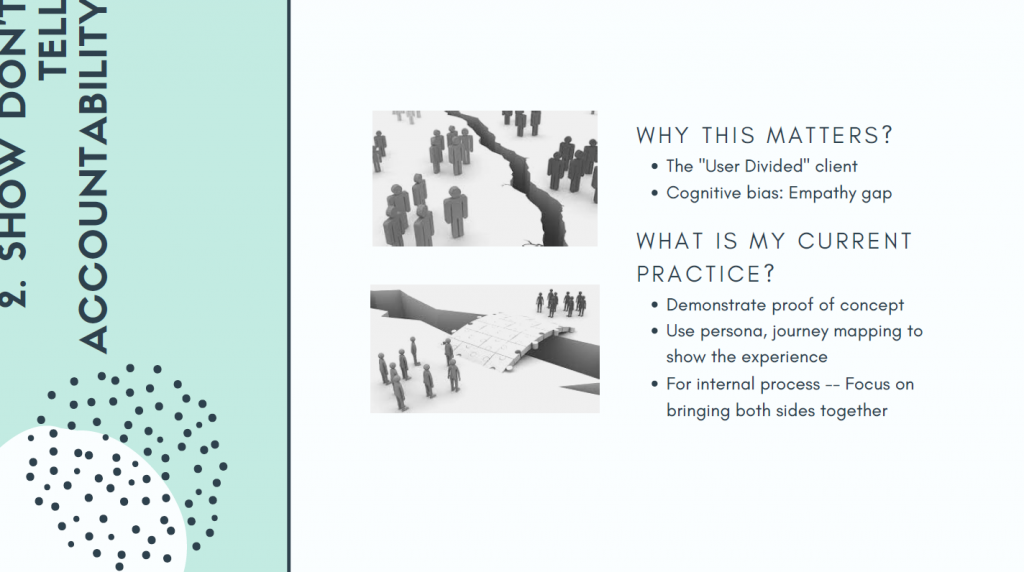
Stop trying to take perspective and go talk to people. There is no substitution for going and talking to the people who are impacted. And if you are a client or a service designer or product designer, and you're trying to make something that works, you have to talk to the people to learn from their own experiences how they use services and products, what worked and what didn’t. These people will have different ideas and takes on the things that will inevitably lead to better solutions.
Lesson Four: Sustainable design leadership is a big change
Sustainable design leadership can be a big change for many of us who work in the UX space. This approach requires a shift from making good products towards making sustainable ones while taking sustainable action and engaging in long-term decision-making in service of others and for those with whom you work. This is all about making things better for the long run.
Sustainable leadership means that you not only do design sustainably but also empower sustainable ways of working for both you and your team. It means that we, as UX designers, work in such a way to ensure our own sustainability.
“I do a lot of work around and ensure that every single process I have is about creating not only short-term wins but long-term solutions that will bring organizations, teams, and individuals where they need to go long-term. But I also want to do it in a way that respects my own sustainability, which brings us to the problem of the UX Designer reward.”
You have probably seen some early indications of this person in the all-in researcher persona. More about such a person in the video below:
Scarcity bias
One of the big cognitive biases at play here is scarcity bias. Scarcity bias is a bias that plays into the space of “rarer is better”: “oh, only one left”, “limited time only”, etc.
When you think that something is rare, you want it more. You think, “Ugh, this is the only time I'll ever get to work on this problem”. And it’s highly likely that you will always jump on such a problem. However, you may end up with a highly overburdened plate, having way too much on the go. You may have very little room for rest, very little room for reward, and very little room for joy.
So sustainable design leadership is all about reintroducing those concepts and building in prioritization. It's systems thinking and management, it’s the understanding that you are part of that system. And when you sustainably manage the system, you have to manage yourself, your resources, and your effort. You have to manage and advocate for your needs. And that can be very uncomfortable.
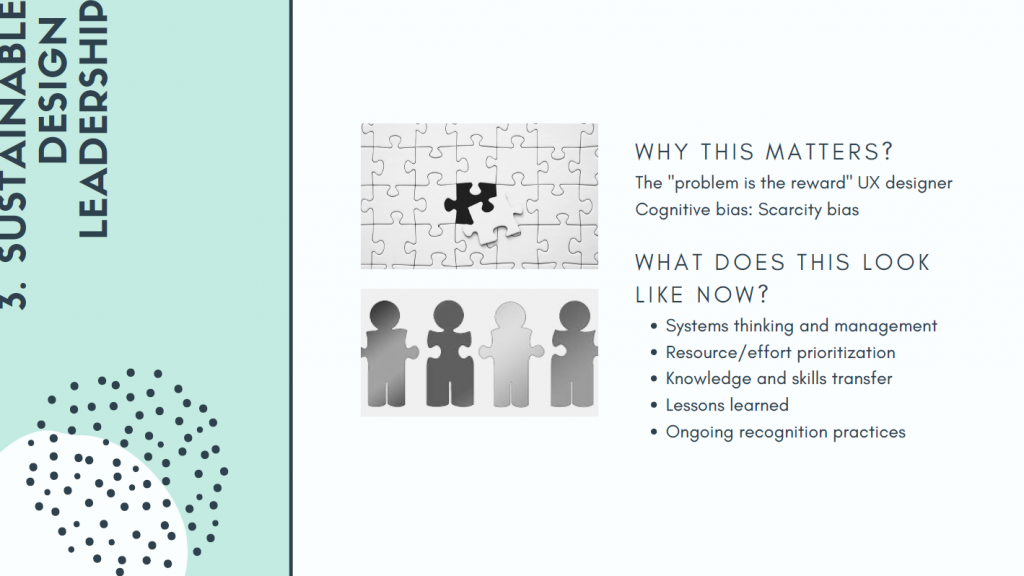
“Ironically, many of us work in the space of needs identification. But if you ask a crowded room of people, “How many of you have had the conversation about what you need to do your job well?”, you may find very few people will put their hands up.”
Normalizing sustainable design leadership is about normalizing the concept that we all have needs and that we need to have those needs met to perform well and be sustainable in our design practices.
Knowledge and skills transfer
Another important practice is knowledge and skills transfer.
“Moving from a silo of excellence into the “I build bridges” phase, I look for opportunities to transfer my knowledge, to build skills in others. I'm not here to solve your problem. Just to empower you with process tools and resources to solve your problems.
I'm not afraid. There will always be more problems to solve. There will always be another wicked challenge. This is not a one-off sale I need to run into and solve before time expires.
In fact, by being able to be more selective about the problems that I focus on when it comes to my own leadership and my own design, I actually create better solutions long term. I practice lessons learned in an ongoing way, and I've built in recognition practices for myself and for my team because at the end of the day, when you design something that works well, it makes people's lives better and makes the clients you serve and the end user have a better time. You need to recognize that win because in recognizing that win, you're more likely to replicate that win.” (And because you and your team are worth celebrating!)
As much as scarcity bias could make us jump at every problem. When the problem is the UX Designer's reward, scarcity bias works in the UX Designer’s favor by choosing to work on fewer problems.
So we develop a much stronger brand and reputation because we are being more selective and we create better things by prioritizing our effort.
Wrapping up
Now you know Dr. Kelly’s UX journey from beginning to today. You’ve met a few personas along the way and hopefully taken away the importance of a foundational understanding, leading with questions, and adopting a reframe practice that helps challenge some of our cognitive biases, including a confirmation bias.
You learned the importance of leading with compassion when it comes to the idea that if you're coming in to be right or to fail, to see the other side, you will never be able to co-create. You now know why it’s vital to build the bridges and get beyond being right towards being effective.
Also, you’ve read about sustainable design and that, as a UX Designer, you deserve to work in a way that is sustainable and align your commitment accordingly.
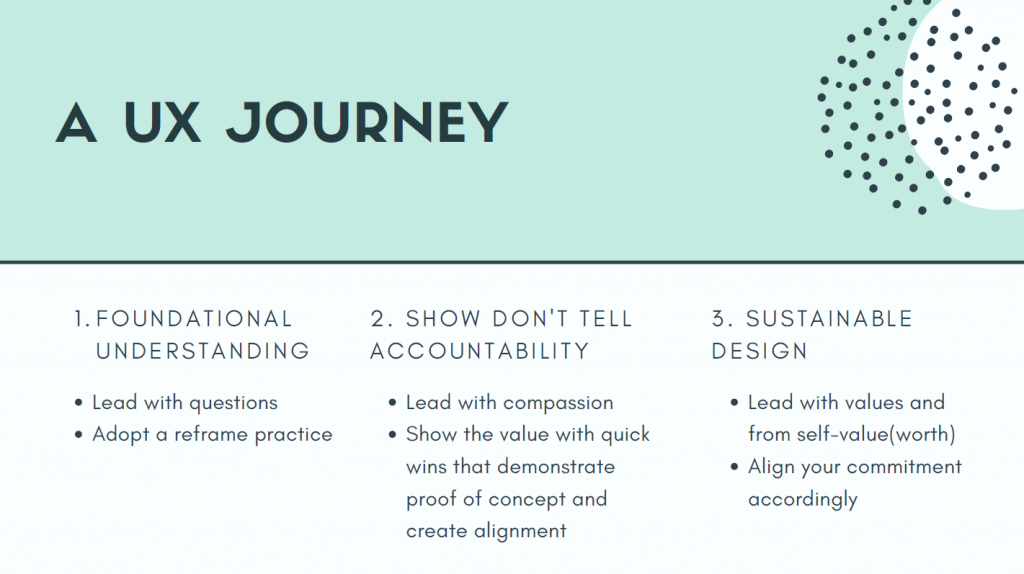
The recording
Do you want to learn about Dr. Deirdre Kelly’s journey in more detail? Then check out the event recording below.


